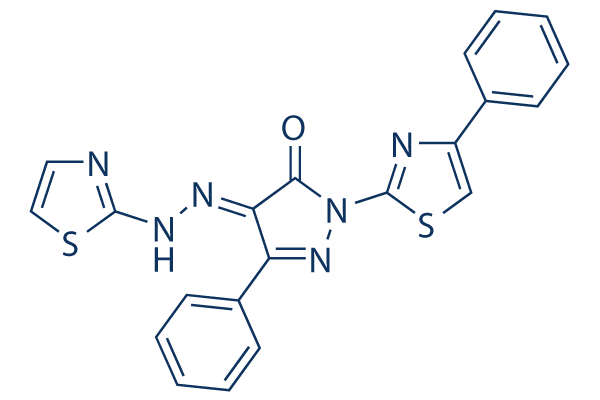|
BTSA1 (BTSA-1) is a novel and potent BAX (BCL2-associated X protein) activator with antitumor activity. By specifically and strongly binding to the N-terminal activation site of BAX and causing conformational changes there, it triggers BAX-mediated apoptosis. While sparing healthy cells, BTSA1-induced BAX activation efficiently promotes apoptosis in leukemia cell lines and patient samples. BAX expression amounts and cytosolic conformation control BTSA1 sensitivity. BTSA1 increased host survival without causing any toxicity while effectively suppressing human acute myeloid leukemia (AML) xenografts. The BCL-2 family protein BAX is a central mediator of apoptosis. By inhibiting BAX and its activators, anti-apoptotic BCL-2 protein overexpression aids in the development of tumors and therapy resistance.
|
Physicochemical Properties
| Molecular Formula |
C21H14N6OS2
|
| Molecular Weight |
430.51
|
| Exact Mass |
430.067
|
| Elemental Analysis |
C, 58.59; H, 3.28; N, 19.52; O, 3.72; S, 14.89
|
| CAS # |
314761-14-3
|
| Related CAS # |
|
| PubChem CID |
3857348
|
| Appearance |
Brown to reddish brown solid powder
|
| Density |
1.5±0.1 g/cm3
|
| Boiling Point |
625.2±48.0 °C at 760 mmHg
|
| Flash Point |
331.9±29.6 °C
|
| Vapour Pressure |
0.0±1.8 mmHg at 25°C
|
| Index of Refraction |
1.791
|
| LogP |
3.68
|
| Hydrogen Bond Donor Count |
1
|
| Hydrogen Bond Acceptor Count |
8
|
| Rotatable Bond Count |
5
|
| Heavy Atom Count |
30
|
| Complexity |
689
|
| Defined Atom Stereocenter Count |
0
|
| SMILES |
S1C([H])=C(C2C([H])=C([H])C([H])=C([H])C=2[H])N=C1N1C(C(=C(C2C([H])=C([H])C([H])=C([H])C=2[H])N1[H])/N=N/C1=NC([H])=C([H])S1)=O
|
| InChi Key |
CTRCXGFSYFTJIW-UHFFFAOYSA-N
|
| InChi Code |
InChI=1S/C21H14N6OS2/c28-19-18(24-25-20-22-11-12-29-20)17(15-9-5-2-6-10-15)26-27(19)21-23-16(13-30-21)14-7-3-1-4-8-14/h1-13,26H
|
| Chemical Name |
5-phenyl-2-(4-phenyl-1,3-thiazol-2-yl)-4-(1,3-thiazol-2-yldiazenyl)-1H-pyrazol-3-one
|
| Synonyms |
| BTSA1; ANA-38; BTSA-1; ANA 38; BTSA 1; ANA38 |
|
| HS Tariff Code |
2934.99.9001
|
| Storage |
Powder-20°C 3 years
4°C 2 years
In solvent -80°C 6 months
-20°C 1 month
|
| Shipping Condition |
Room temperature (This product is stable at ambient temperature for a few days during ordinary shipping and time spent in Customs)
|
|
Biological Activity
| Targets |
Bax (IC50 = 250 nM); Bax (IC50 = 144 nM)
|
| ln Vitro |
BTSA1 has no capacity to directly activate the pro-apoptotic homolog BAK. Recombinant soluble BAX is potently and dose-responsively translocated to the mitochondrial membrane by treatment with BTSA1, which is followed by the induction of BAX oligomerization. Cancer cells are more likely to undergo apoptosis when BAX is activated by BTSA1. With IC50 values ranging between 1 and 4 μM, BTSA1 decreases the viability of all AML cell lines in a dose-dependent manner, with a complete effect occurring within 24 hours of treatment. All five AML cell lines exhibit dose-dependent caspase-3/7 activation[1].
|
| ln Vivo |
BTSA1 potently suppresses human acute myeloid leukemia (AML) xenografts and increases host survival without toxicity. The healthy stem cellenriched (LSK) cells, common myeloid progenitors, granulocyte-monocyte progenitors, and megakaryocyte-erythrocyte progenitors are well-tolerated in mice and exhibit no toxic effects. A 10 mg/kg dose of BTSA1 reaches sufficient levels (~15 μM) to cause BAX activation and apoptosis in leukemia cells while also having a significant half-life in mouse plasma (T1/2 = 15 hr) and oral bioavailability (%F = 51). As a result, BTSA1 has excellent pharmacokinetics, is orally bioavailable, significantly inhibits tumor growth in leukemia xenografts by inducing apoptosis, and at therapeutically effective doses exhibits no detectable toxicity in the hematopoietic system or other tissues[1].
|
| Cell Assay |
AML cells (seeded at 2 × 104 cells/well) are incubated with serial dilutions of BTSA1 or BTSA2 or vehicle (0.15% DMSO) in no FBS media for 2.5 hours before 10% FBS replacement is added to a final volume of 100 l. At 24 hours, cell viability is assessed.
|
| Animal Protocol |
| Formulated in 1% DMSO, 30% PEG-400, 65% D5W (5% dextrose in water), 4% Tween-80; 10 mg/kg; P.O. and I.V. | | NOD-SCID IL2Rg null (NSG) mice/ICR (CD-1) male mice, 6-8 weeks old | |
|
| References |
[1]. Direct Activation of BAX by BTSA1 Overcomes Apoptosis Resistance in Acute Myeloid Leukemia. Cancer Cell. 2017 Oct 9;32(4):490-505.e10.
|
|
Solubility Data
| Solubility (In Vitro) |
| DMSO: ~81 mg/mL (~188.1 mM) | | Water: < 1mg/mL | | Ethanol: < 1mg/mL |
|
| Solubility (In Vivo) |
(Please use freshly prepared in vivo formulations for optimal results.)
|
| Preparing Stock Solutions |
|
1 mg |
5 mg |
10 mg |
| 1 mM |
2.3228 mL |
11.6141 mL |
23.2283 mL |
| 5 mM |
0.4646 mL |
2.3228 mL |
4.6457 mL |
| 10 mM |
0.2323 mL |
1.1614 mL |
2.3228 mL |
*Note: Please select an appropriate solvent for the preparation of stock solution based on your experiment needs. For most products, DMSO can be used for preparing stock solutions (e.g. 5 mM, 10 mM, or 20 mM concentration); some products with high aqueous solubility may be dissolved in water directly. Solubility information is available at the above Solubility Data section. Once the stock solution is prepared, aliquot it to routine usage volumes and store at -20°C or -80°C. Avoid repeated freeze and thaw cycles. |
